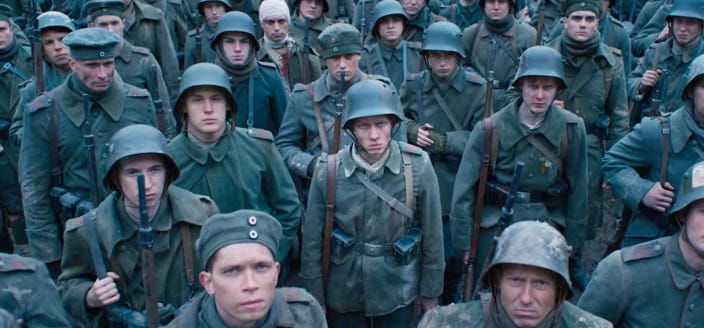All Quiet On the Western Front (2022)
Netflix's new German-language version of All Quiet On the Western Front walks a fine line between adapting Erich Maria Remarque’s classic 1929 novel and coherently presenting a time period that’s been out of living memory for a decade. Wow. This movie is brutal.
The main character is Paul Baumer, who eagerly takes up the uniform with his fresh-faced group of school friends. They’ve been sent off to war cheering by their schoolmaster, who tells them that war is glorious and they are the Iron Youth of Germany. Their destiny is to fight for the Fatherland and then return home to a hero’s welcome and public adoration without end.
However, Paul and his friends find out almost immediately that war isn’t glorious but ugly, bloody, wet, muddy, uncomfortable, and no one really knows what they’re fighting about. The chances of survival are very slim as well. As the group is walking to the battlefield an officer tells them that they’ll be lucky if they last six weeks.
Paul lasts longer than six weeks; he watches his friends die one by one while he somehow is spared, and he’s given the sober task of collecting identification tags from bodies after the day’s fighting is over. He turns into a killing machine, dispassionately plunging his bayonet into any soldier from the other side, and he becomes so entrenched in army life it’s as if nothing else exists.
Behind the scenes, there are those who are looking to end the war as soon as possible because the longer it goes on, the more the death toll climbs, with thousands of men dying on a daily basis. Others oppose the idea because. again, the soldiers are the Iron Youth and the fight must continue for the glory of the Fatherland.
All Quiet On the Western Front is often saturated in very cold steel blues and muddy browns, which causes the blood of the battlefield to show up in grisly detail. The film is rated R for graphic violence, so it’s not uncommon for the camera to pan over a dead soldier with half of his leg blown off or to see pieces of human bodies lying around. While our eyes are spared the worst, this movie is not for the fainthearted or to be watched for fun.
There’s very much a sense of how dehumanizing the war was, as we periodically see the uniforms and boots of dead soldiers cleaned and recycled for the next young men who join the cause. Sometimes they don’t even take off the old nametags. We mostly see soldiers in groups as opposed to individuals, and everyone, civilians and soldiers alike, are so doggedly focused on their tasks that they might as well not be human or even have faces.
The movie follows the book fairly closely, at least the basic gist, but the book is much more cerebral. The novel’s Paul has time to reflect on what is happening to him, such as when one of his friends dies and Paul pictures him in his coffin a few months or years down the road. He also has time to realize that his supposed enemy is human just like he is, with a family waiting for him and a whole life left behind, which further dampens his eagerness to fight.
In the film, Paul doesn’t seem to be doing much of his own thinking but presenting others’ thoughts, such as when he reads a letter aloud from his friend Kat’s wife. Other than that, Paul mostly just persists as a soldier, stone-faced and reticent, more like a robot than a man. While it’s realistic, it makes it harder to connect with him and feel for him, especially when (spoiler alert) he meets his own end, a moment that the movie unfortunately fumbles.
On the other hand, the time period is presented adequately, with a nice balance of exposition and showing instead of telling, particularly when it comes to the soldiers’ isolation. There are very few women anywhere in the film, and the ones that are around are either off in the distance or one of the many crowds cleaning and recycling uniforms. Or there might be a woman on a poster for a local theater. Even the music communicates isolation, with frequent staccato chords that sound like doors closing or curtains falling.
Throughout the film I was reminded over and over of the passage of time. It’s interesting that the movie was shot by a German film company, seeing as pacifist Erich Maria Remarque was considered a traitor by the Nazis. His books were burned, and a few years after he fled Germany for the United States his younger sister, Mrs. Elfriede Scholz was beheaded in a case of judicial murder (The Nazis even had the further gall to send Remarque’s other sister, Erna a bill for housing and executing Scholz). It wasn’t until after the war that Remarque’s books were published in Germany again.
The Netflix film feels like Germany is making up for lost time. While the 1930 and 1979 versions were both unique in their own ways, they were made in Hollywood with English dialogue. The German film feels as if it has less of a filter than those other two films and more immediacy, as Remarque’s story is finally seen in its native language. While it’s too bad the filmmakers chose to skim over quite a bit of what made Paul a compelling audience conduit, in other ways they have more than hit the target.
All Quiet On the Western Front is currently streaming on Netflix. Rated R.
My grade: A
Principal cast: Felix Kammerer, Albrecht Schuch, Aaron Hilmer, Morin Klaus, Adrian Grunewald, Edin Hasanovic, Daniel Bruhl, Andreas Dohler
Directed by: Edward Berger
Written by: Edward Berger, Lesley Paterson and Ian Stokell




